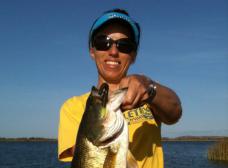Post-spawn blues
Although we have only just recently ‘officially’ welcomed Spring to South Africa and are starting to enjoy the budding and blooming trees, sweet scents, chirping birds and thunder showers, for most of the bass in our area ‘Spring Fever’ has passed.
Yes, you may still find a couple of bass staging in pre-spawn or even sitting on the nests, but most of them have already moved on to their post-spawn staging areas.
To my experience in the Limpopo where it starts warming up earlier than our more southern regions, when most of us start thinking SPAWNING BASS, the bass have already spawned and moved on. June, July and early August is usually the time for this, so if you find yourself struggling and wondering where all the spawning bass are right now, wonder no more...it is time to get into post-spawn mode.
Post-spawn is a notoriously tough fishing period for pro and novice alike. Bass are inactive, trying to recover their strength after the stress and exertion of the spawning season. They have moved out of the shallows and scattered back into their staging areas and will take a couple of weeks to fully recover their pre-spawn vigour.
Post-spawn staging areas are often the same ones used during pre-spawn and are never far from the spawning location. It is not necessary to travel all the way across the lake looking for post-spawn bass. Cruise just off the shallows and keep a lookout for any changes in structure or cover. Typical post-spawn staging structure/cover will include the first depth change (drop-off), drop-off to timber or rock, transition in bottom composition (gravel to rock, rock to shale, etc.) or vegetation (bulrushes to lily pads, lily pads to submerged weeds, etc.). One of the best places to look for post-spawn bass is off secondary points adjacent to the spawning flats.
When bass are inactive during post-spawn it is difficult to coax them to bite because they are too tired and worn out to eat and will not actively chase down a lure. I have often heard frustrated anglers telling me all about the five to ten bass they could see hanging around the limbs of a submerged tree/rock pile/weed bed, and presenting all sorts of different lures, even bumping the bass with the bait but to no avail. There was just no way to get the bass to bite!
My advice for this dilemma: First of all, when you see a bass...back off! If you can see him, he can see you. Note the exact spot and come back a little later but stay far enough away for the bass not to see you. Approach stealthily!
Now is the time to use a reaction bait. What is a reaction bait you may ask? As defined by Bassmaster.com... “Reaction baits — lures fished in a way that causes a bass to strike out of reflex or surprise; spinnerbaits, crankbaits and lipless crankbaits are frequently fished in a manner designed to generate reaction bites”. In other words, the bass will strike your lure instinctively as a reaction to the movement close by, not because it is hungry.
Do not cast the bait right on top of the bass. You will spook it! Cast beyond the target, but make sure the retrieve will bring the lure right over the bass’s head or through the cover closest to the fish. If there is timber, rock or weed...fish through it, over it, in it. Bump it! Change the speed of your retrieve as you pass over the fish. These are all little ‘triggers’ that may force the bass into reacting to your lure and strike with aggression.













0 Comments